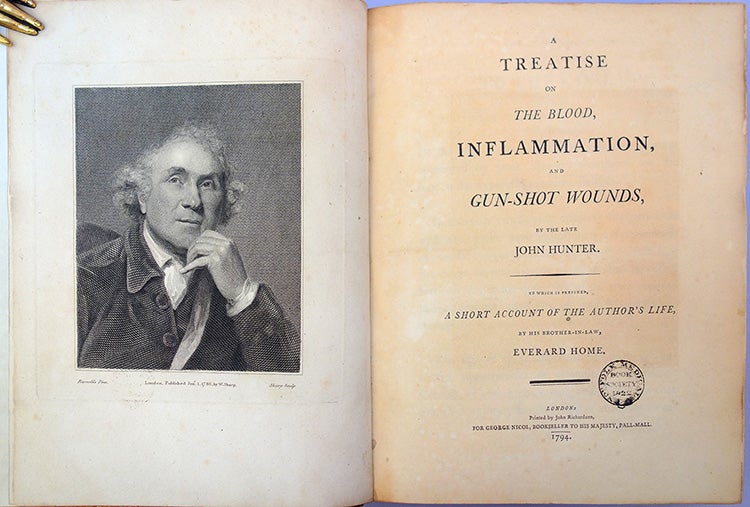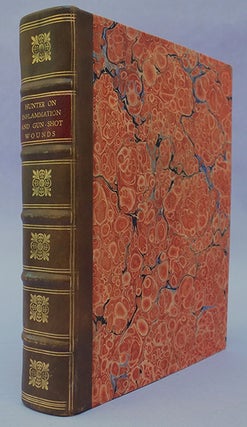A treatise on the blood, inflammation, and gun-shot wounds
Publisher Information: London: J. Richardson for G. Nicol, 1794.
Hunter, John (1728-93). A treatise on the blood, inflammation, and gun-shot wounds . . . to which is prefixed, a short account of the author’s life, by his brother-in-law, Everard Home. 4to. lxvii [1], 575 [1]pp. Engraved portrait frontispiece by William Sharp (1749-1824) after the painting by Sir Joshua Reynolds (1723-92), 9 engraved plates by William Skelton. London: John Richardson for George Nicol, 1794. 257 x 204 mm. Quarter calf gilt, marbled boards in period style. Some foxing and toning, otherwise very good.
First Edition. Hunter’s epoch-making last work, in which he published for the first time his observations on war injuries made during the Seven Years’ War 32 years before, along with his studies of inflammation, which were of prime importance to pathology. Hunter was ahead of his time in recognizing and describing the three basic factors of wound pathology: (1) that an external agent in the air, and not the air itself, is a factor in wound inflammation; (2) that a good blood supply is essential in maintaining the natural defenses of the body; and (3) that the presence of devitalized tissue in a gunshot or other deep and contused wound prevents the wound from healing and promotes sepsis. He advocated a conservative system of deep wound management in which the natural functions of suppuration and drainage would be allowed to operate; this policy made sense in the context of 18th-century surgical practice, in which the causes of infection were unknown and antiseptic practices unheard-of. With regard to inflammation, Hunter recognized it as one of the most widespread phenomena in pathology and classified it into three types: (1) adhesive, in which adherence of contiguous parts causes localization of disease; (2) suppurative, in which pus is formed; and (3), ulcerative, in which tissue loss occurs through the action of the lymphatics.
992 copies of the first edition of Hunter’s Treatise were printed. This was the last of Hunter’s works to be produced at his private press at Castle Street; Hunter was in poor health when the work went to press, and died after correcting only one third of the proofs. The remainder of the work’s publication was supervised by the author’s nephew Matthew Baillie (1761-1823) and brother-in-law Everard Home (1756-1832). Garrison-Morton.com 2283. Norman 1122. Long, History of Pathology, pp. 90-92. Qvist, Hunter, pp. 76-77; 146-53. Robb-Smith, “John Hunter’s Private Press,” Journal of the History of Medicine and the Allied Sciences 25 (1970): 262-69.
Book Id: 43998Price: $5,000.00


